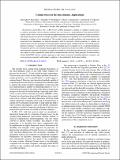| dc.contributor.author | McCauley, Alexander Patrick | |
| dc.contributor.author | Johnson, Steven G | |
| dc.contributor.author | Rodriguez-Wong, Alejandro | |
| dc.contributor.author | Joannopoulos, John | |
| dc.date.accessioned | 2010-07-15T20:50:50Z | |
| dc.date.available | 2010-07-15T20:50:50Z | |
| dc.date.issued | 2010-01 | |
| dc.date.submitted | 2009-10 | |
| dc.identifier.issn | 1050-2947 | |
| dc.identifier.uri | http://hdl.handle.net/1721.1/56726 | |
| dc.description.abstract | Our previous article [Phys. Rev. A 80, 012115 (2009)] introduced a method to compute Casimir forces in arbitrary geometries and for arbitrary materials that was based on a finite-difference time-domain (FDTD) scheme. In this article, we focus on the efficient implementation of our method for geometries of practical interest and extend our previous proof-of-concept algorithm in one dimension to problems in two and three dimensions, introducing a number of new optimizations. We consider Casimir pistonlike problems with nonmonotonic and monotonic force dependence on sidewall separation, both for previously solved geometries to validate our method and also for new geometries involving magnetic sidewalls and/or cylindrical pistons. We include realistic dielectric materials to calculate the force between suspended silicon waveguides or on a suspended membrane with periodic grooves, also demonstrating the application of perfectly matched layer (PML) absorbing boundaries and/or periodic boundaries. In addition, we apply this method to a realizable three-dimensional system in which a silica sphere is stably suspended in a fluid above an indented metallic substrate. More generally, the method allows off-the-shelf FDTD software, already supporting a wide variety of materials (including dielectric, magnetic, and even anisotropic materials) and boundary conditions, to be exploited for the Casimir problem. | en_US |
| dc.description.sponsorship | Defence Advanced Research Projects Agency (Contract No. N66001-09-1-2070-DOD) | en_US |
| dc.language.iso | en_US | |
| dc.publisher | American Physical Society | en_US |
| dc.relation.isversionof | http://dx.doi.org/10.1103/PhysRevA.81.012119 | en_US |
| dc.rights | Article is made available in accordance with the publisher's policy and may be subject to US copyright law. Please refer to the publisher's site for terms of use. | en_US |
| dc.source | APS | en_US |
| dc.title | Casimir forces in the time domain: Applications | en_US |
| dc.type | Article | en_US |
| dc.identifier.citation | McCauley, Alexander P. et al. “Casimir forces in the time domain: Applications.” Physical Review A 81.1 (2010): 012119. © 2010 The American Physical Society. | en_US |
| dc.contributor.department | Massachusetts Institute of Technology. Institute for Soldier Nanotechnologies | en_US |
| dc.contributor.department | Massachusetts Institute of Technology. Department of Mathematics | en_US |
| dc.contributor.department | Massachusetts Institute of Technology. Department of Physics | en_US |
| dc.contributor.department | Massachusetts Institute of Technology. School of Science | en_US |
| dc.contributor.approver | Johnson, Steven G. | |
| dc.contributor.mitauthor | Johnson, Steven G. | |
| dc.contributor.mitauthor | Rodriguez, Alejandro W. | |
| dc.contributor.mitauthor | McCauley, Alexander Patrick | |
| dc.contributor.mitauthor | Joannopoulos, John D. | |
| dc.relation.journal | Physical Review A | en_US |
| dc.eprint.version | Final published version | en_US |
| dc.type.uri | http://purl.org/eprint/type/JournalArticle | en_US |
| eprint.status | http://purl.org/eprint/status/PeerReviewed | en_US |
| dspace.orderedauthors | McCauley, Alexander P.; Rodriguez, Alejandro W.; Joannopoulos, John D.; Johnson, Steven G. | en |
| dc.identifier.orcid | https://orcid.org/0000-0001-7327-4967 | |
| dc.identifier.orcid | https://orcid.org/0000-0002-7244-3682 | |
| mit.license | PUBLISHER_POLICY | en_US |
| mit.metadata.status | Complete | |
